Physical Address
304 North Cardinal St.
Dorchester Center, MA 02124
Voluntary movement is essential to the well-being of living animals. Such behaviors are accomplished by signals that direct the actions of individual muscles. Although these signals originate in the cerebral cortex, they are modulated by a variety of subcortical structures. One such group of structures is the basal nuclei and their functionally associated cell groups. Classically, motor systems have been divided into pyramidal and extrapyramidal on the basis of whether the pathway is mediated by corticofugal neurons (pyramidal) or by the basal nuclei, cerebellum, or pathways originating in the brainstem (extrapyramidal). However, this distinction is overly simplistic if not inaccurate. Consequently, it is not used here. The basal nuclei are involved in a wide variety of motor and affective behaviors, in sensorimotor integration, and in cognitive functions.
These nuclei were traditionally called the basal ganglia rather than the basal nuclei, even though “ganglia” is usually reserved for groups of nerve cell bodies in the peripheral nervous system. The official term basal nuclei is used throughout this chapter, although the unofficial term basal ganglia is also commonly seen in the literature. For practical purposes, these terms may be considered interchangeable, although basal nuclei is the correct and preferred term.
The basal nuclei consist of cell groups embedded in the cerebral hemispheres. Although not classified as cell groups of the basal nuclei in a strict sense, the subthalamic nucleus, substantia nigra, and pedunculopontine tegmental nucleus are integral parts of the pathways passing through these forebrain cell groups. Collectively, the basal nuclei and their associated nuclei function primarily as components in a series of parallel circuits from the cerebral cortex through the basal nuclei to the thalamus and then back to the cerebral cortex.
Four fundamental concepts are crucial to understanding of the basal nuclei. First, damage to or disorders of the basal nuclei result in disruption of movement and may also cause significant deficits in other neural functions, such as cognition, perception, and mentation. Second, the basal nuclei are anatomically and functionally segregated into parallel circuits that process different types of behaviorally significant information. Third, the basal nuclei function primarily through balancing between inhibition and disinhibition (release from inhibition) of thalamocortical pathways. Fourth, diseases of the basal nuclei can be described as structural lesions of elements of the basal nuclei and/or disruptions of the neurochemical interactions between them. These neurochemical relationships rely not simply on the neurotransmitters involved but also on the characteristics of the transmitter receptors, on the locations of the synapses, and on other inputs received by these cells.
In summary, the basal nuclei integrate and modulate cortical information along multiple independent parallel channels. These channels affect behavior indirectly by feedback to the cerebral cortex and directly by providing information to subcortical centers that influence movements. Disruption of these channels by stroke or disease results in dysfunction initially observed in the motor sphere, and frequently with subsequent disruption in other behavioral domains.
The basal nuclei are typically divided into dorsal and ventral divisions. The dorsal basal nuclei include the caudate and putamen (together constituting the neostriatum ) and the globus pallidus (constituting the paleostriatum ) ( Fig. 26.1 A ). Associated with the dorsal basal nuclei, in a functional sense, are the substantia nigra, the subthalamic nucleus, and the parabrachial pontine reticular formation (containing the pedunculopontine tegmental nucleus ). The ventral basal nuclei are located inferior to the anterior commissure and include the nucleus accumbens, substantia innominata, nucleus basalis of Meynert, and olfactory tubercle. This ventral region is intimately associated with portions of the amygdala and ventral tegmental area. For the purposes of this chapter, the basal nuclei are regarded as making up two complexes: the striatal complex and the pallidal complex ( Fig. 26.1 B ). Because the globus pallidus and putamen are adjacent and together have a lens-shaped configuration, the term lenticular nuclei is sometimes used to denote those structures ( Fig. 26.1 C ).
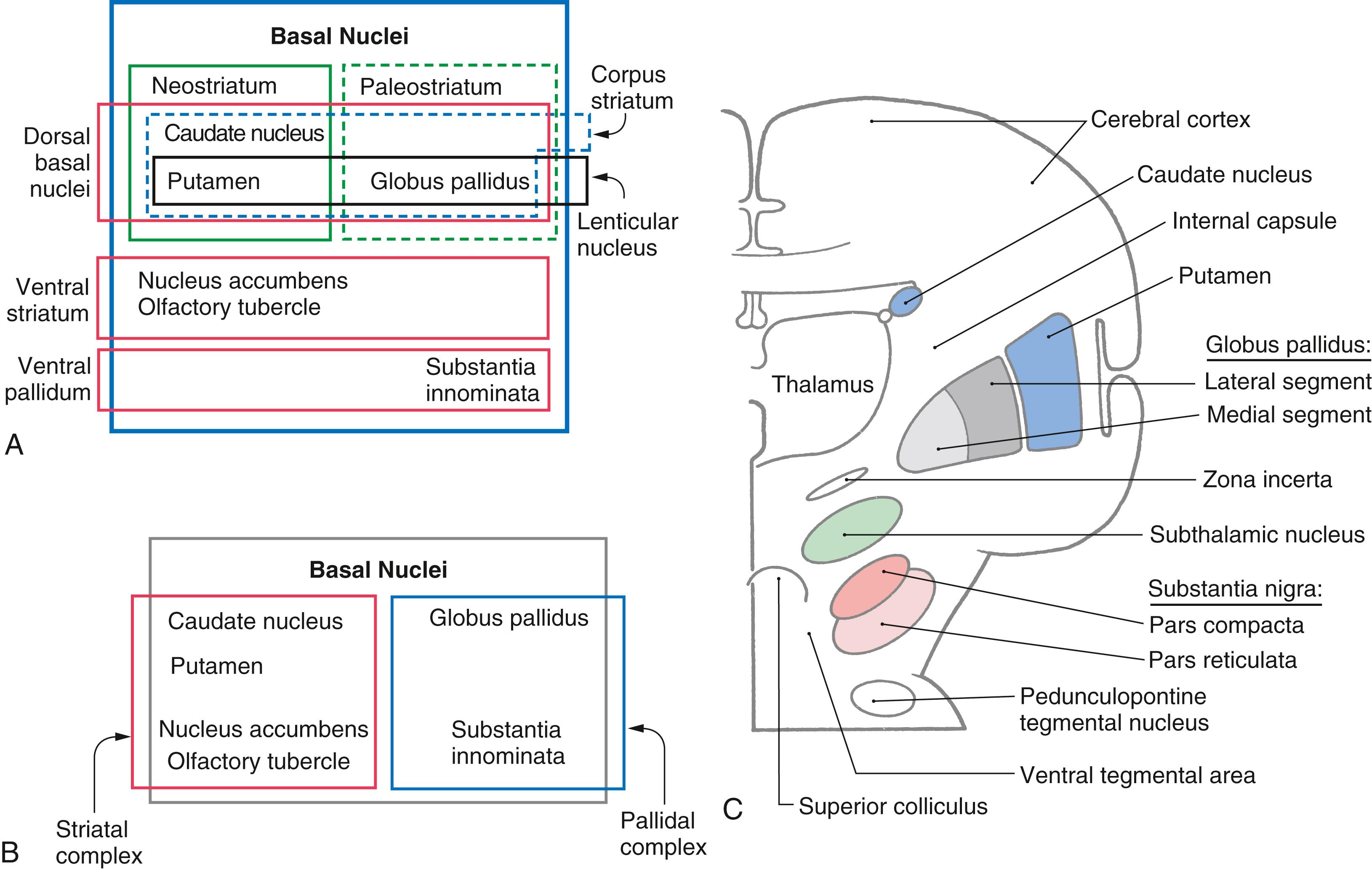
The telencephalic regions of the basal nuclei are supplied by the medial striate artery, the lenticulostriate branches of the M 1 segment of the middle cerebral artery, and the anterior choroidal artery ( Fig. 26.2 ). The diencephalic and mesencephalic regions are supplied by the posteromedial branches of the P 1 segment of the posterior cerebral artery and branches of the posterior communicating artery. Diseases of these vessels may result in various behavioral or motor deficits, depending on which vessel and region are affected.
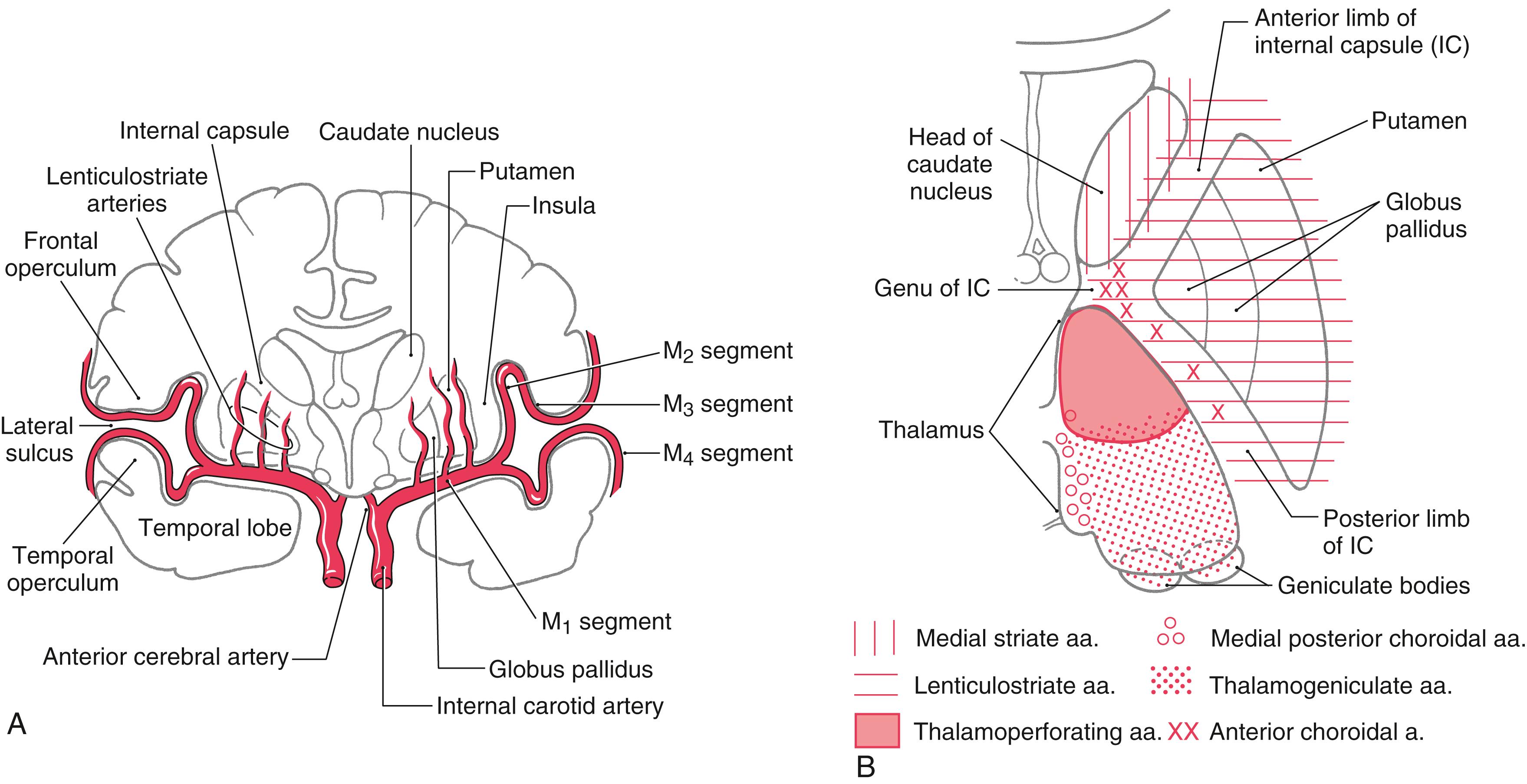
The striatal complex is a functional unit composed of the neostriatum and ventral striatum ( Fig. 26.3 A, B ). The neostriatum (sometimes imprecisely termed the striatum, especially by clinicians) consists of the caudate nucleus and putamen. These two nuclei have the same embryologic origin and similar connections. Although fused rostroventrally, they are separated throughout most of their extents by fibers of the internal capsule. The ventral striatum is composed of the nucleus accumbens and portions of the olfactory tubercle ( Figs. 26.1 A, B and 26.3 A ). The nucleus accumbens is located rostroventrally in the hemisphere, at the point where the putamen is continuous with the head of the caudate ( Figs. 26.3 A and 26.4 A, B ). It is internal to part of the anterior perforated substance. Portions of the olfactory tubercle are considered part of the ventral striatum because of functional, cytoarchitectural, and chemoarchitectural similarities. A defining characteristic of the striatal complex, patches (also called striosomes ) are particularly prominent in the head of the caudate ( Fig. 26.4 B ). Patches are acetylcholinesterase-poor regions within the striatal complex. They contain large amounts of one or more neuropeptides and one or more types of opiate receptors. Patches are surrounded by matrix ( Fig. 26.4 B ), which contains high concentrations of acetylcholinesterase and therefore stains darkly when tissue is exposed to histochemical stains that react with this enzyme. In addition to histochemical and receptor differences, these regions also receive projections from different cortical regions and project to different targets.
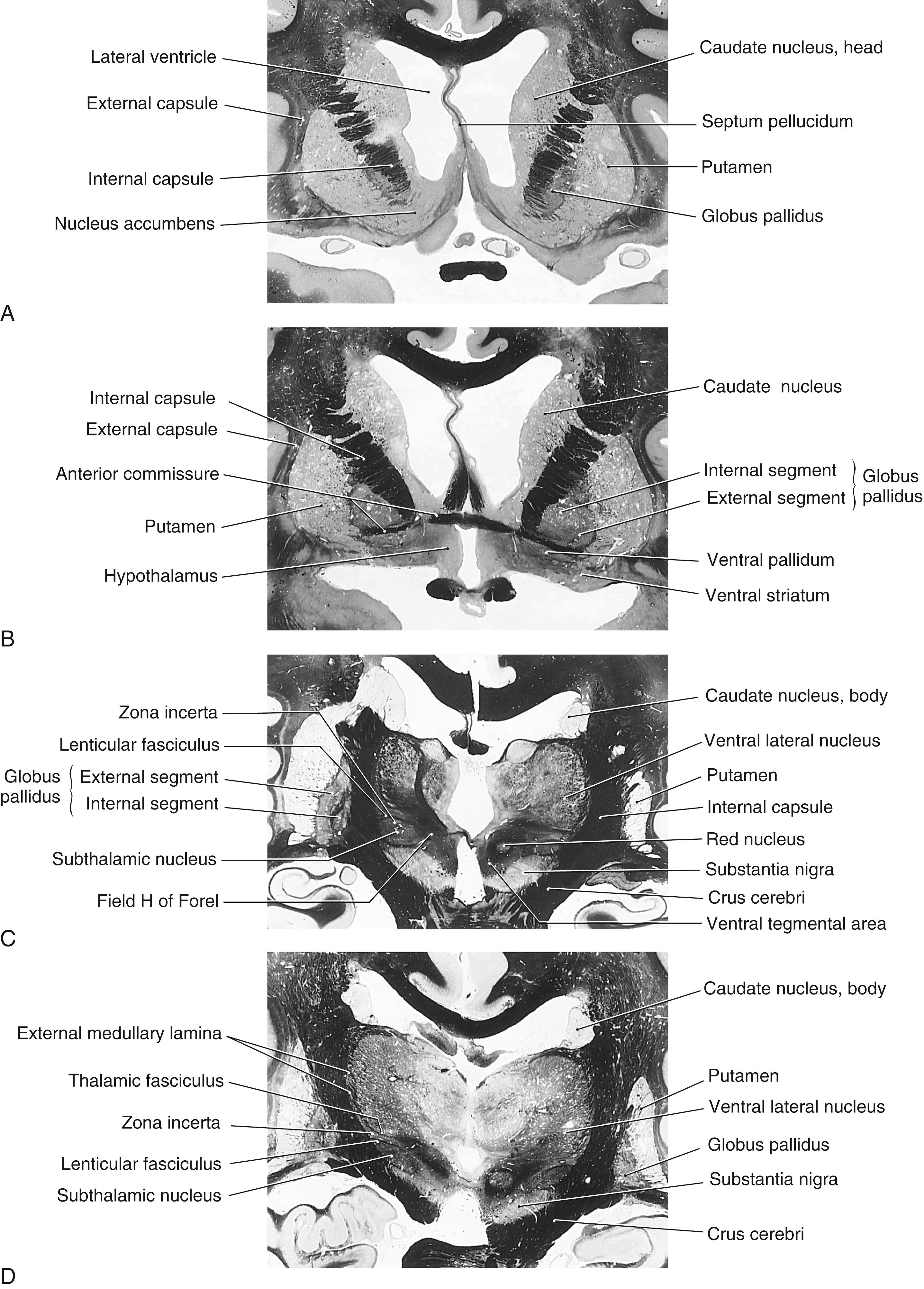
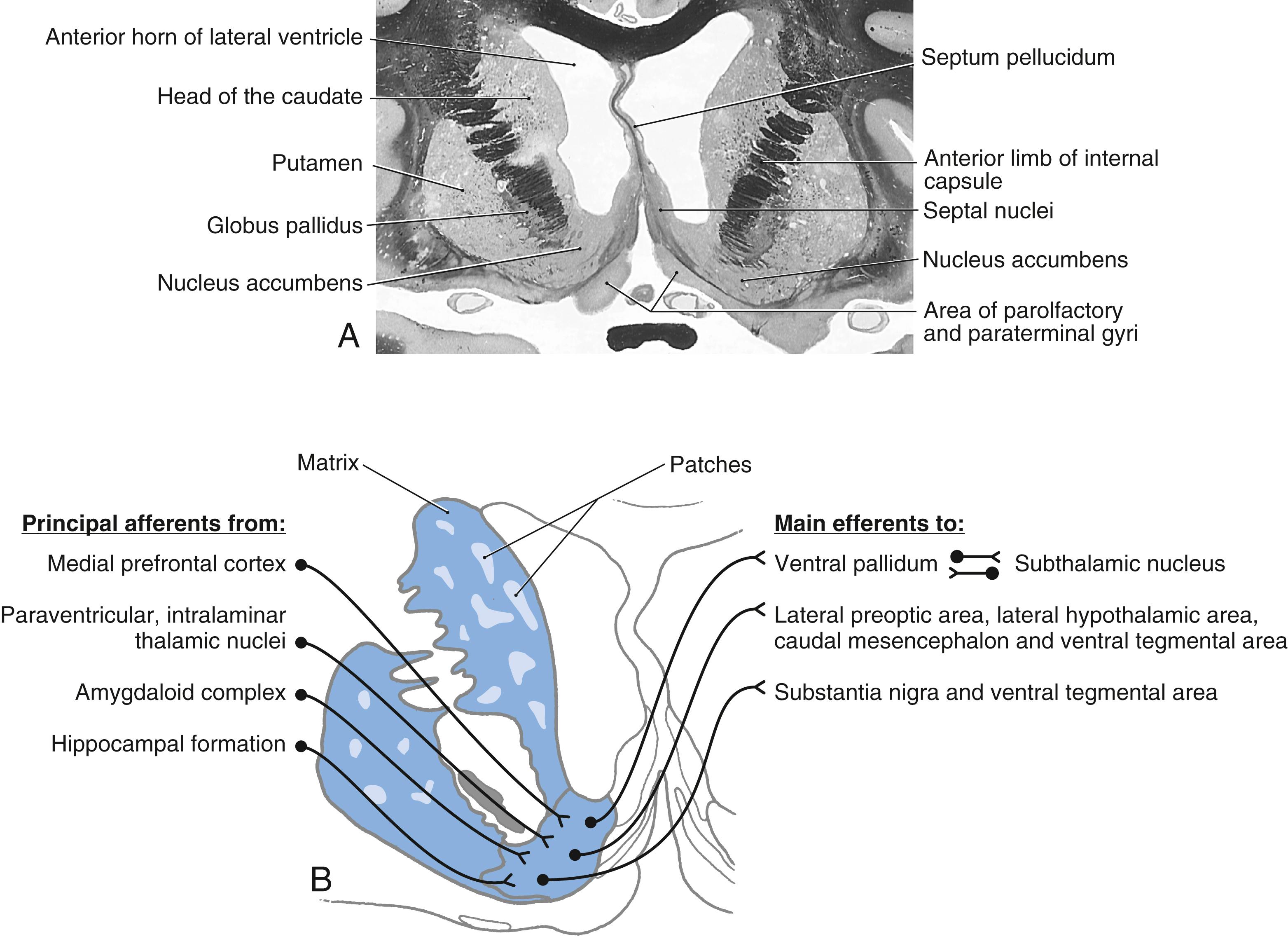
The largest afferent projections to the neostriatum are from the cerebral cortex ( corticostriatal fibers ) ( Fig. 26.5 A ), chiefly the supplementary motor area. Other afferents arise from the thalamus ( thalamostriatal fibers ), substantia nigra ( nigrostriatal fibers ), and parabrachial pontine reticular formation ( pedunculopontostriatal fibers ) ( Fig. 26.5 A ). The efferent projections of the striatum reach primarily the pallidum ( striatopallidal fibers ) and the nigral complex ( striatonigral fibers ) and to a small degree the subthalamic nucleus.
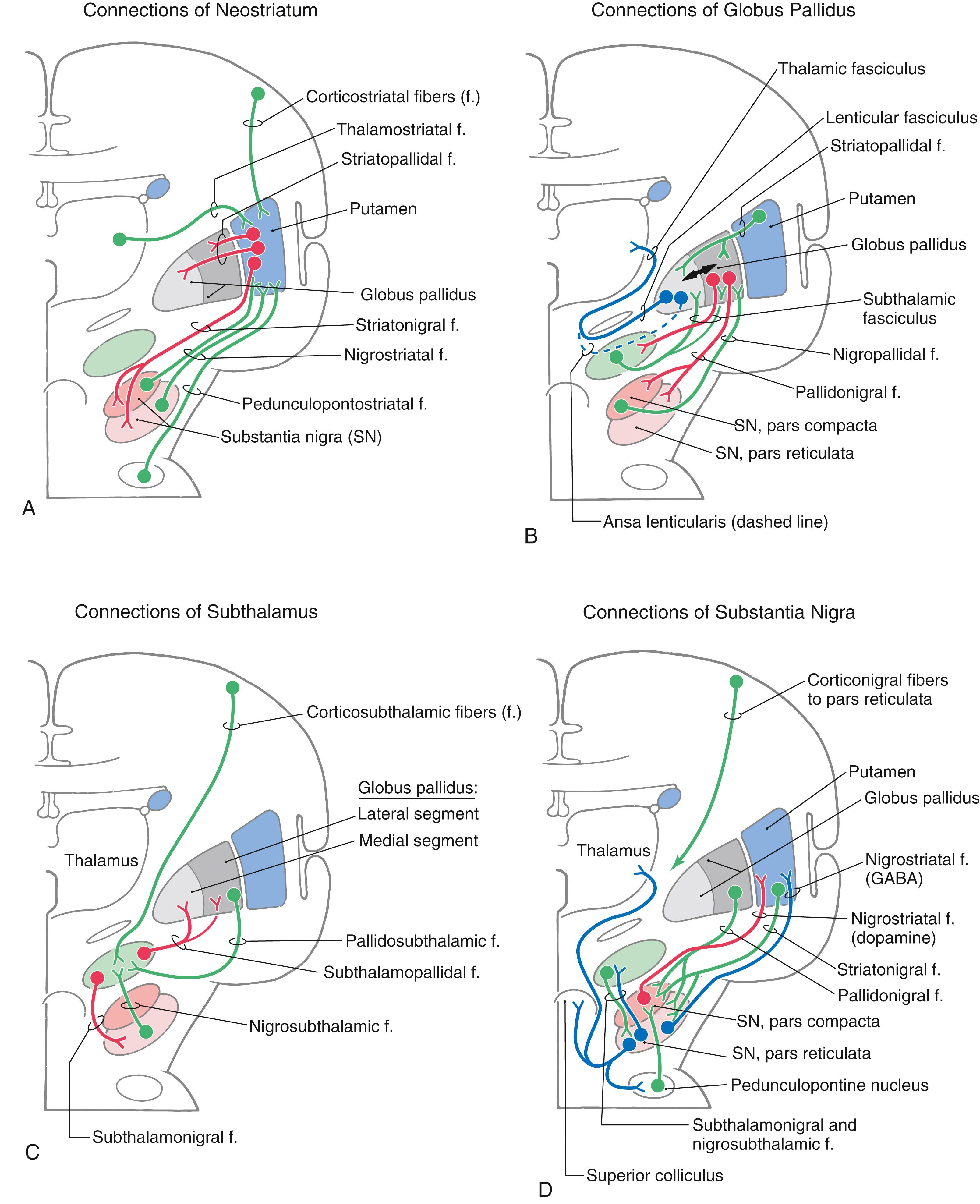
Most (up to 95%) of the neurons in the neostriatum are medium spiny neurons, so named because of their medium-sized cell bodies and the large numbers of spines on their dendrites ( Fig. 26.6 ). Most medium spiny cells have dendritic fields that are restricted to the patch or matrix compartment in which the cell bodies are located.
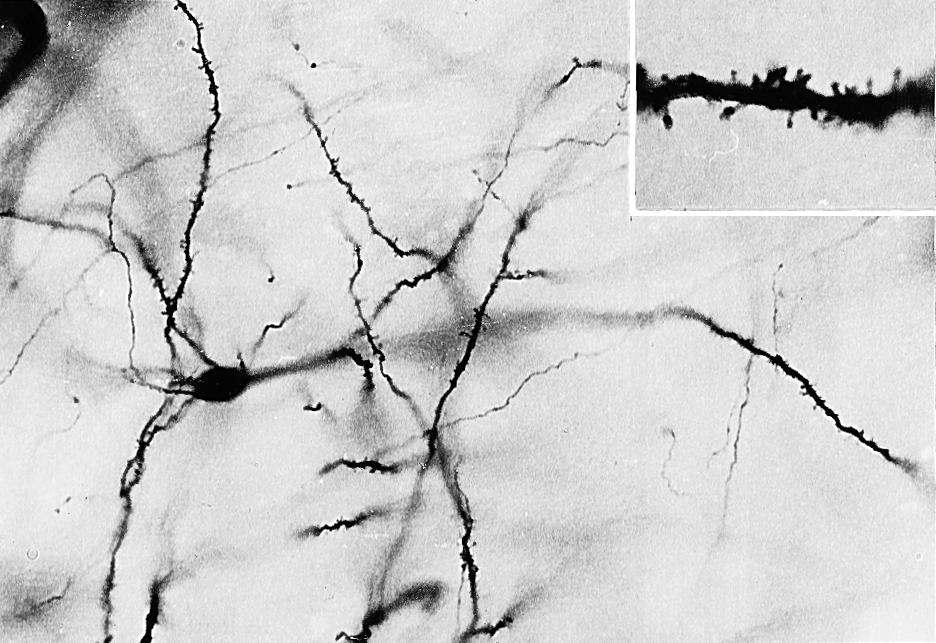
The nucleus accumbens forms the majority of the ventral striatum ( Fig. 26.4 A ). This nucleus is divided into a core region and a shell region. The core region is cytoarchitecturally and histochemically identical to the neostriatum. It has similar efferent and afferent connections, albeit from different cortical regions and to different pallidal and midbrain nuclei. The shell is somewhat histochemically distinct and has a more diffuse set of connections. It receives projections primarily from allocortical regions and sends projections to the ventral pallidum, substantia nigra–ventral tegmental area, parabrachial nucleus, periaqueductal gray, lateral hypothalamus, and lateral preoptic area ( Fig. 26.4 B ).
Medium spiny neurons fire few action potentials spontaneously and thus require activation via their afferent fibers. These cells release the inhibitory neurotransmitter γ-aminobutyric acid (GABA) and also, in some cases, neuroactive peptides such as substance P and enkephalin. Thus, when medium spiny neurons are activated, they subserve both direct inhibitory and neuromodulatory functions at their targets. The axons of medium spiny neurons are the efferent fibers of the neostriatum, collectively forming the striatopallidal fibers.
Also found in the neostriatum are large, acetylcholine-containing local circuit neurons that modulate local activity within the neostriatum. Huntington disease is characterized by progressive loss of medium spiny neurons and acetylcholine-containing neurons throughout the striatal complex.
The pallidal complex is composed of the globus pallidus and the ventral pallidum. The latter is largely synonymous with the substantia innominata ( Fig. 26.3 B, C ). The pallidal complex contains primarily GABAergic neurons with high rates of spontaneous activity. Consequently, these cells tonically inhibit their targets.
The globus pallidus is divided into medial ( internal ) and lateral ( external ) segments by a sheet of white matter (the medullary lamina) ( Fig. 26.3 C ). The substantia innominata is located inferior to the anterior commissure and internal to the anterior perforated substance. One important cell group in the substantia innominata is the basal nucleus of Meynert. This nucleus contains large acetylcholine-containing neurons, which are lost in Alzheimer disease. The resulting cholinergic deficit is thought to be responsible, at least in part, for the cognitive dysfunction in this disease, and three cholinesterase inhibitors are approved as pharmaceutical agents for treatment of Alzheimer dementia. However, Alzheimer disease is not considered a basal nuclear disorder because its primary clinical features relate to dysfunction of acetylcholine-containing cells in other brain regions, including the cerebral cortex, hippocampus, and septum. This disease is further characterized by other biochemical and pathologic features, such as senile plaques and neurofibrillary tangles.
The two divisions of the globus pallidus are reciprocally connected ( pallidopallidal fibers ) ( Fig. 26.5 B ) but subserve different functions. The main afferent input to the pallidum is from the striatal complex. Medium spiny neurons from the neostriatum that project to the medial segment and substantia nigra use GABA and substance P; those that project to the lateral segment use GABA and enkephalin ( Fig. 26.5 B ).
The medial division consists of the medial segment of the globus pallidus. It subserves the direct basal nuclear pathway (described later) and projects primarily to the thalamus ( pallidothalamic fibers ) ( Fig. 26.5 B ). These fibers exit the globus pallidus as two bundles: the ansa lenticularis and the lenticular fasciculus ( Figs. 26.3 C, D ; see also Figs. 26.8 and 26.9 ). The ansa lenticularis originates from lateral portions of the medial segment and loops around the posterior limb of the internal capsule to enter the prerubral field ( field H of Forel ). The lenticular fasciculus ( field H 2 of Forel ), on the other hand, originates in the posteromedial portion of the medial segment. These fibers traverse the internal capsule as small groups of axons, merge to form the lenticular fasciculus between the zona incerta and subthalamic nucleus, and then enter field H of Forel. In the Forel field, the ansa lenticularis and lenticular fasciculus join the thalamic fasciculus ( field H 1 of Forel ), which courses immediately superior to the zona incerta ( Fig. 26.3 C, D ; see also Figs. 26.8 and 26.9 ). These fibers ultimately terminate in ventral anterior, ventral lateral, and centromedian nuclei of the thalamus. The medial division of the pallidal complex is a principal efferent nucleus of the basal nuclei, the axons of these cells comprising the ansa lenticularis and the lenticular fasciculus.
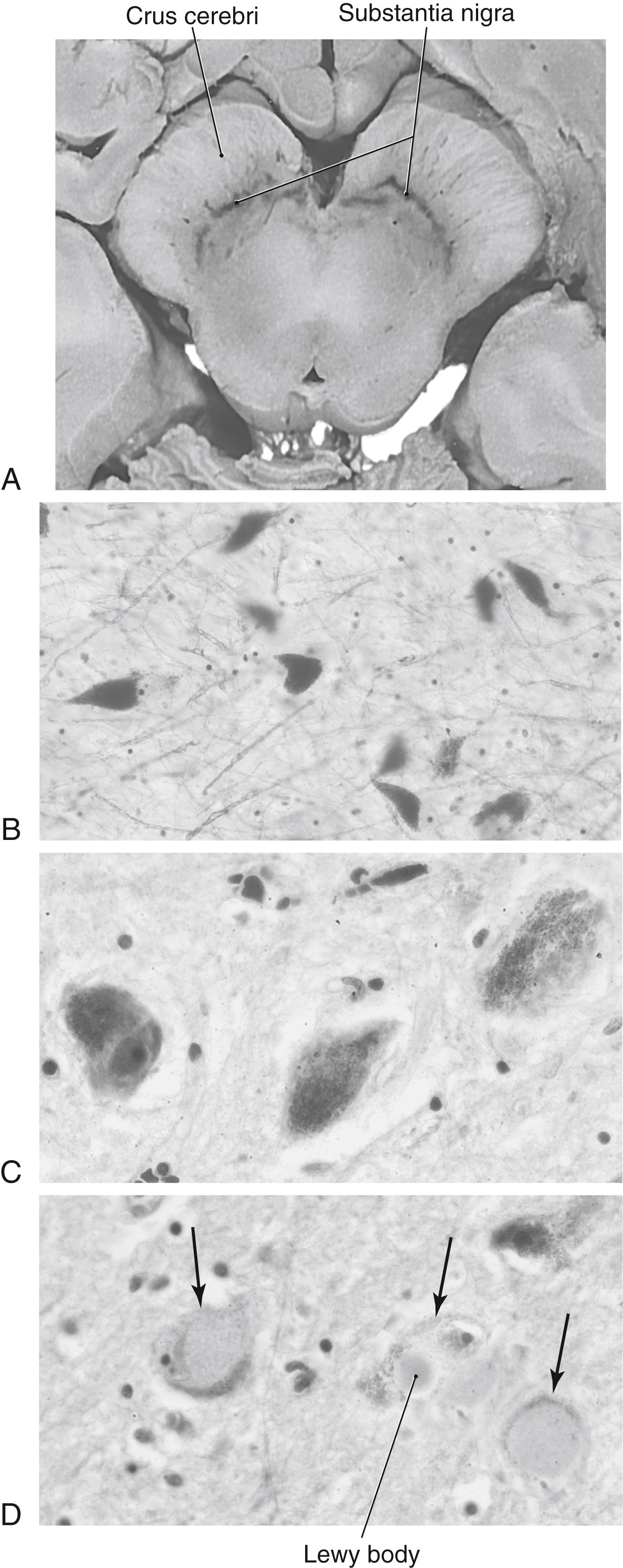
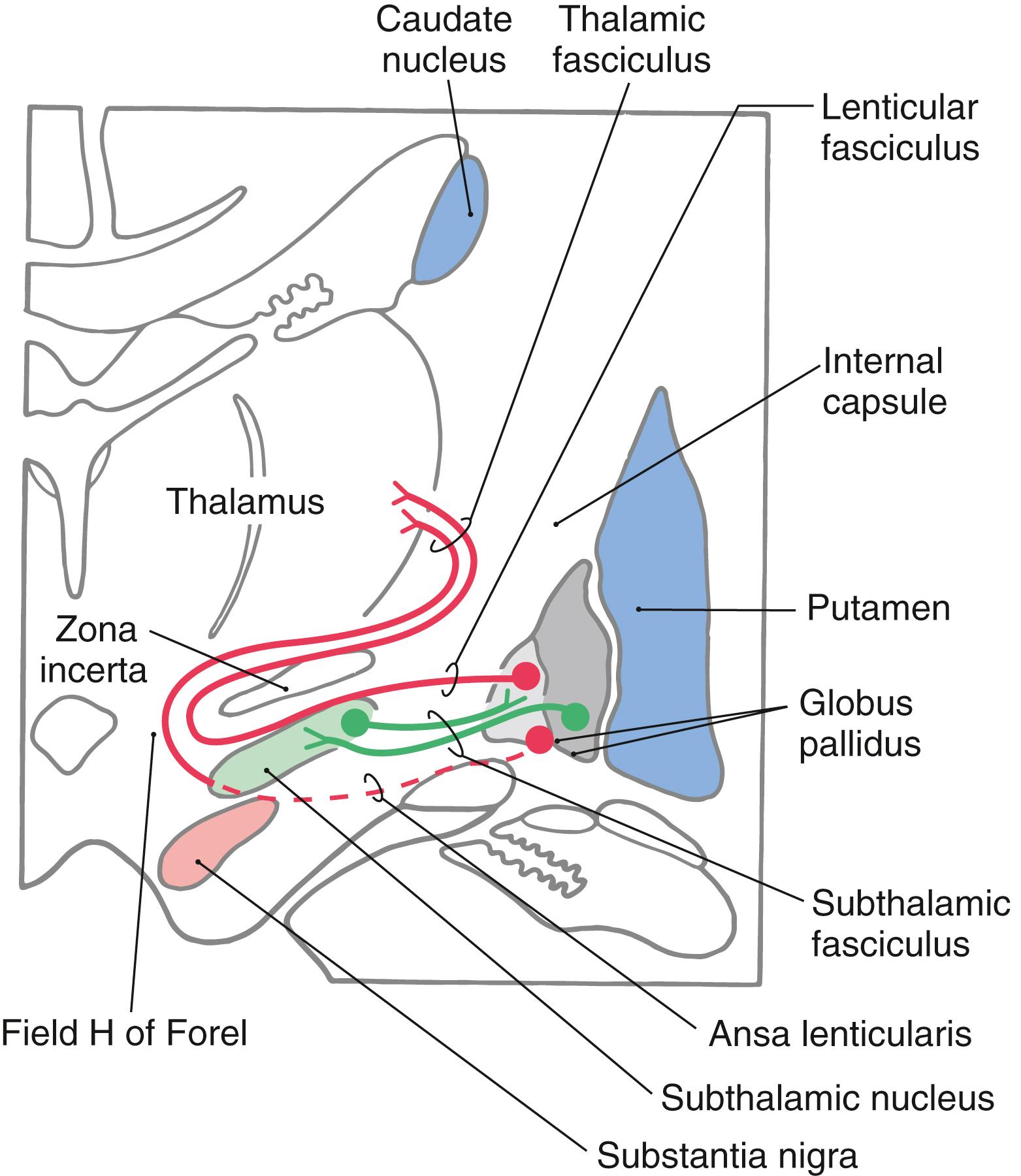
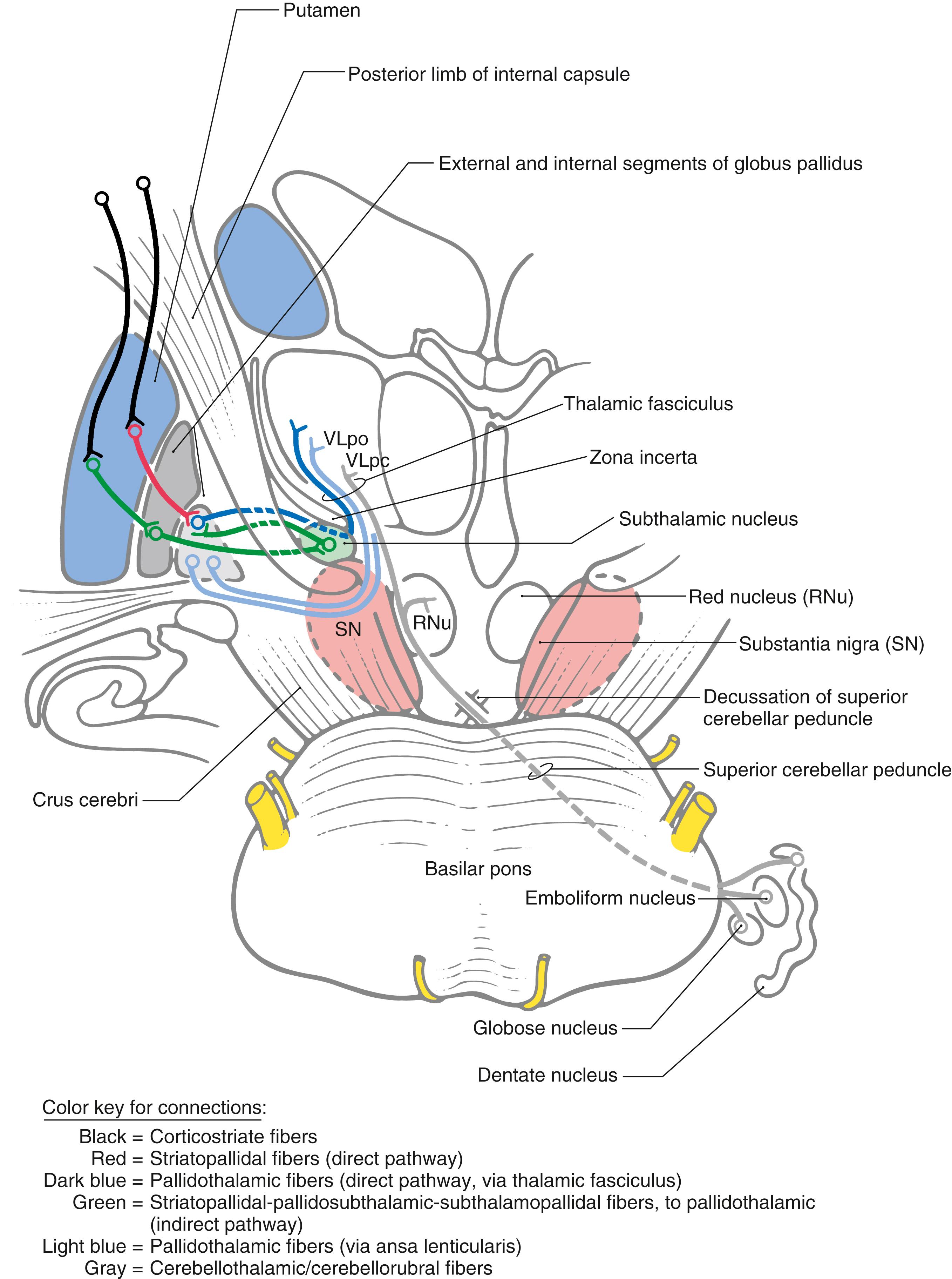
The lateral division comprises the external (or lateral) segment of the globus pallidus and the ventral pallidum. This division subserves the indirect basal nuclear pathway (see later). These nuclei receive a large input from the striatal complex ( striatopallidal fibers ) and small projections from the subthalamic nucleus ( subthalamopallidal fibers ) and the substantia nigra pars reticulata ( nigropallidal fibers ). They project strongly to the subthalamic nucleus ( pallidosubthalamic fibers ) and are also connected with the substantia nigra ( pallidonigral fibers ) ( Fig. 26.5 B ).
The subthalamic nucleus is a lens-shaped cell group that makes up the largest part of the subthalamus (ventral thalamus). It is immediately inferior to the zona incerta and rostral to the substantia nigra ( Fig. 26.3 C, D ). It receives projections from the lateral pallidal division ( pallidosubthalamic fibers ), cerebral cortex ( corticosubthalamic fibers ), nigral complex ( nigrosubthalamic fibers ), and parabrachial pontine reticular formation. The subthalamic nucleus projects to both pallidal divisions ( subthalamopallidal fibers ) and to the substantia nigra ( subthalamonigral fibers ) ( Fig. 26.5 C ). These connections, especially the subthalamopallidal projections to the medial globus pallidus, are an essential part of the indirect pathway underlying basal nuclear function (described later).
Subthalamic neurons use the excitatory neurotransmitter glutamate. Most of the time, subthalamic cells are inactive because of the constant inhibition by cells of the external pallidal segment. However, if this inhibition is removed, as in Parkinson disease (see later in this chapter), subthalamic neurons have a high level of activity resulting in a characteristic motor deficit. This activity is mediated in part by a large corticosubthalamic projection. One strategy for treatment of Parkinson disease involves delivery of electrical impulses to the subthalamic nucleus through surgically placed electrodes; this deep-brain stimulation interferes with the function of the subthalamic nucleus and reduces its output.
The nigral complex is composed of the substantia nigra and the ventral ( anterior ) tegmental area ( Fig. 26.3 C, D ). The substantia nigra is divided into a cell-dense portion ( pars compacta ) and a reticulated portion (referred to here as the pars reticulata, although it can be divided into a pars reticulata and a pars lateralis ). The pars reticulata is located at and within the medial edge of the descending corticofugal fibers that form the crus cerebri. The pars compacta and the adjacent ventral tegmental area appear to subserve similar functions and to have a similar chemoarchitectural organization. The major afferents to the nigral complex are from the striatal and pallidal complexes. The nigral complex also receives cortical ( corticonigral ), subthalamic ( subthalamonigral ), and pedunculopontine fibers ( Fig. 26.5 D ).
The pars compacta contains a large number of neuromelanin-containing cells, whose dark color gives the nucleus its name ( substantia nigra, “black substance”). Cells of the pars compacta in healthy individuals appear characteristically dark in brain slices and are packed with small black granules in histologic sections ( Fig. 26.7 A-C ). Neurons in the pars compacta use the neurotransmitter dopamine and project primarily to the neostriatum as nigrostriatal fibers. As described in detail below, dopamine released by these cells can excite or inhibit neostriatal neurons, depending on the type of receptor on the postsynaptic membrane.
The pars reticulata is formed by loose aggregations of medium-sized to large GABAergic neurons that are indistinguishable from those of the medial pallidum. Neurons in the pars reticulata have axons with an extensive system of collaterals; consequently, they may project to and inhibit one or more target structures. These targets include the neostriatum ( nigrostriatal fibers ), thalamus ( nigrothalamic fibers ), superior colliculus ( nigrotectal fibers ), and parabrachial pontine reticular formation. These cells have a high rate of discharge and tonically inhibit their targets. Projections of pars reticulata neurons represent an important pathway by which the basal nuclei influence other motor centers.
The pars compacta and the pars reticulata are interconnected. Dendrites of dopaminergic pars compacta neurons extend into the pars reticulata, where they release free dopamine (by a nonvesicular mechanism). The concentration of dopamine modulates the resting membrane potential of pars reticulata cells, making them either more or less likely to discharge, depending on the subtype of dopamine receptor they possess. In turn, pars reticulata neurons have axon collaterals that ramify extensively in the pars compacta and form GABAergic synapses. Collectively, these interactions form modulatory loops between neurons of the pars compacta and the pars reticulata.
These modulatory loops are influenced by the output of the striatal system. Neurons in the patches project predominantly onto the cells in the pars compacta, whereas the neurons in the matrix project predominantly onto the cells in the pars reticulata. Thus the striatonigral projection from patches directly inhibits the dopaminergic nigrostriatal neurons, and the projection from the matrix inhibits the GABAergic neurons in the pars reticulata. Consequently, inhibition of the pars reticulata is reduced and its targets, such as the pars compacta, are released from inhibition and may become more active.
The ventral tegmental area is located medial to the substantia nigra. It contains large numbers of dopaminergic neurons and forms connections with the ventral striatum, the amygdala, and other limbic system structures. Cells of the ventral tegmental area project to and terminate on striatal neurons that have postsynaptic D 2 (dopamine) receptors. In schizophrenia, there is an increase in number and in sensitivity of these receptors. Neuroleptic drugs help control schizophrenia by blocking (downregulating) these D 2 receptors. Pathways from the ventral tegmental area to the nucleus accumbens in the ventral striatum play an important role in reward and motivation, and may contribute to addiction.
Nuclei in the region of the parabrachial pontine reticular formation, primarily the pedunculopontine tegmental nucleus, are intimately connected with all portions of the basal nuclei and their associated nuclei. For example, GABAergic substantia nigra pars reticulata neurons project onto cells of the pedunculopontine tegmental nucleus. In turn, acetylcholine-containing pedunculopontine tegmental neurons project to the substantia nigra pars compacta. In addition, the pedunculopontine tegmental nucleus is reciprocally connected with the subthalamic nucleus. Moreover, the parabrachial pontine nuclei are connected with motor centers in the brainstem, which project to the spinal cord via the descending spinal pathways. Thus these nuclei serve as an efferent pathway for the basal nuclei. It has been suggested that damage to the connections between the pedunculopontine nucleus and the basal nuclei may partially account for motor deficits, such as postural instability and gait abnormalities, in some patients.
The ventral basal nuclear pathways are similar to those of the dorsal basal nuclei. The pathways originate in the allocortex (limbic-related cortical areas) and the orbital and medial prefrontal cortices. The corticostriatal pathway terminates in the ventral striatum (nucleus accumbens and portions of the olfactory tubercle). Striatopallidal neurons then project to the ventral pallidum (substantia innominata). The pallidothalamic neurons subsequently project to the mediodorsal nucleus of the thalamus, whose neurons then project to the cerebral cortex. As with the dorsal basal nuclei, distinct regions of each nucleus in these pathways are connected with each other. Thus there is a clear loop through the ventral basal nuclei for information originating from different areas of the cortex, as is discussed later.
Become a Clinical Tree membership for Full access and enjoy Unlimited articles
If you are a member. Log in here